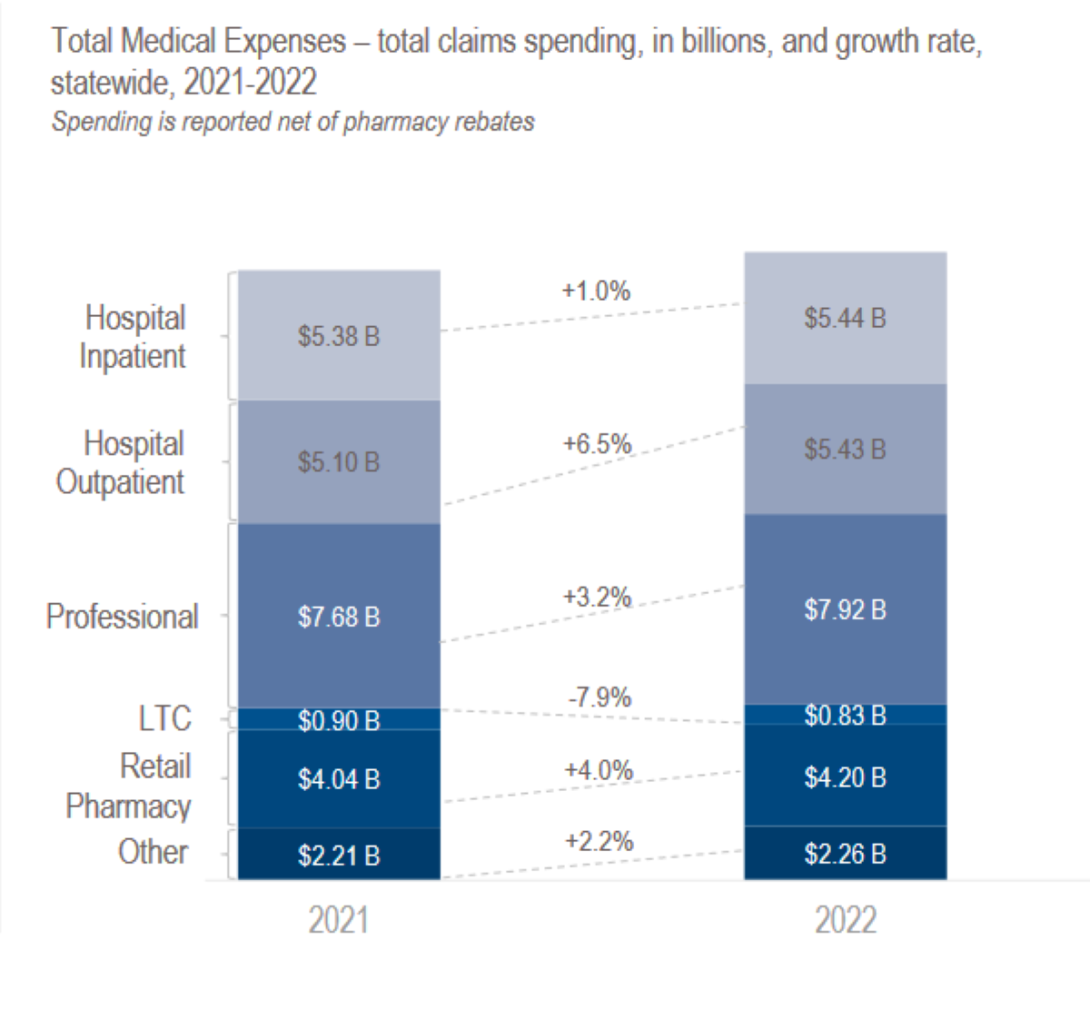
Increased spending on hospital outpatient services, behavioral health and retail pharmacies in Oregon helped drive per-person health care costs to grow 3.6% between 2021 and 2022.
Those were findings in the latest of a series of state reports on such spending, with the newest installment providing a snapshot of health care spending in Oregon in the latter part of the pandemic.
The annual report released Tuesday is part of a state program authorized by lawmakers in 2019 that seeks to slow increases in the cost of health care that have forced many patients to choose between hefty bills or delaying care.
The 96-page report comes amid continuing debate over how best to achieve the state’s goal of limiting per-capita cost growth to 3.4% per year, even as Oregon regulators are finalizing rules on financial penalties for insurers, hospitals and providers that exceed that target over multiple years.
Also this week, Oregon lawmakers are holding hearings on health care price transparency, hospital finances and other related topics. Meanwhile, the Oregon State Public Research Interest Group has released the results of a survey showing how consumers are struggling with the high cost of care.
Overall, per-person spending on health care increased by $325 to $9,261 2022, according to the state report. That 3.6% jump came even as inflation increased by 6.5% during this period, a figure not included in the state report.
However, it came after overall spending dropped by 1.2% the year before — reflecting a nationwide interruption in the provision of health care due to efforts to limit spread of the COVID-19 virus. In the second half of the pandemic, things began to loosen up, with patients pursuing care they had deferred.
“We’re really delighted to see this. This is likely due to some increased investments, increased payments — things that were happening in this time period.”
Sarah Bartelmann, the program’s manager, told the Sustainable Health Care Cost Growth Target Advisory Committee Tuesday morning that some of the increased spending was welcome. Because of Oregon’s drug decriminalization law, Measure 110, state spending on behavioral health contracts to support programs intended to reduce the harm to individuals from using drugs increased 62% to $647.2 million in 2022, according to the report.
Commercial health insurers increased per-person spending on behavioral health by 14%. For Medicaid, that number was 9.5%.
“We’re really delighted to see this,” Bartelmann said. “This is likely due to some increased investments, increased payments — things that were happening in this time period.”
She said that included increased funding for the Oregon State Hospital, the state’ psychiatric hospital. The increased spending on behavioral health won’t be used to penalize health care companies in the future, she said.
The largest increase in spending on medical claims in 2022 was for hospital inpatient and outpatient services, which grew by 7.5% to $10.86 billion, the report found. Meanwhile, spending on prescription drugs increased 4% to $4.2 billion. Professional services increased by 3.2% to $7.92 billion.
“In the face of workforce challenges and rising inflation, many hospital systems pushed for higher reimbursement from payers, increasing these costs for all patient populations using those services,” according to the report.
Lisa Goodman, Hospital Association of Oregon vice president of communications, said in an emailed statement to The Lund Report that for the last four years, “hospitals have struggled as workforce shortages, supply chain fractures, emergency department overcrowding, capacity challenges, and high inflation have fueled the challenges we see today.”

Consumers weary of hikes
The state report aligns with a new survey released by the Oregon State Public Research Group. The survey, conducted by public affairs firm Strategies 360, polled 500 voters in Oregon in November 2023.
Two out of five respondents said their health care costs have risen in the last 12 months, particularly for the 43% who don’t have adequate insurance.
The two biggest contributors to health-care related expenses survey respondents identified were copayments and deductibles, as well as prices charged by hospitals.
When asked if hospitals charged fair prices, 58% of respondents disagreed. Nearly three-quarters of respondents said that lawmakers should take action to address hospital prices with transparency requirements, prohibiting facility fees, surprise billing for ambulances and others.
“This survey just confirms what we already know: health care continues to cost too much and deliver too little for Oregonians,” said Charlie Fisher, OSPIRG state director. “In particular, lawmakers should look at hospital prices and billing when they think about how to bring down health care costs overall.”
Goodman, of the hospital association, said in a statement that workforce costs, which account for half of a hospital’s expenses, have risen 30% in that time period. Additionally, payments from the Medicaid-funded Oregon Health Plan only cover 70 cents for every dollar a hospital spends on care.
“That deficit, combined with rising costs, are reasons Oregon’s community hospitals continue to struggle to find the stable financial footing necessary to continue providing the care their communities depend on,” she wrote.
Legislative hearings ahead
The Oregon Senate Health Care Committee on Wednesday will hold an informational hearing on “Facility Fees,” “Health Care Price Transparency in Oregon” and other topics.
State Sen. Deb Patterson, a Salem Democrat who chairs the committee, told The Lund Report that while the state report on health care spending is focused on insurers and providers, she hopes her hearing will focus more on consumers.
"Consumers need to have a little more transparency," she said.
Calling the health care industry "the most opaque in the country," she said that consumers have difficulties knowing what their insurance will cover and what they'll be on the hook for.
The committee is scheduled to hear from Piper Block, research and data manager for the Oregon Health Authority, on a dashboard managed by the agency that shows that hospitals across Oregon charge significantly different prices for the same procedure. Also scheduled is Chris Whaley, associate professor at Brown University, who has researched variations in hospital prices and how market shares contribute to them.
Researchers from Georgetown University and health officials in Connecticut will give presentations to the Committee on facility fees. They are charges hospitals tack on to patient bills for outpatient services provided by medical practices that are not owned by the hospital but are provided on its campus.
Patterson said that consumers are not charged an extra fee to pick up a prescription at a pharmacy, and she questioned why they should have an additional charge at a hospital when they have already paid for care.
On Thursday, Becky Hultberg, president of the Hospital Association of Oregon, will give the Oregon House Behavioral Health and Health Care Committee an update on hospital finances.
